The Furan Resin Market is estimated to be valued at USD 21.0 billion in 2025 and is projected to reach USD 35.6 billion by 2035, registering a compound annual growth rate (CAGR) of 5.4% over the forecast period.
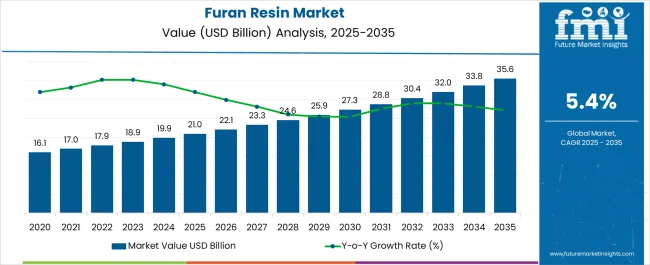
| Metric | Value |
|---|---|
| Furan Resin Market Estimated Value in (2025 E) | USD 21.0 billion |
| Furan Resin Market Forecast Value in (2035 F) | USD 35.6 billion |
| Forecast CAGR (2025 to 2035) | 5.4% |
The Furan Resin market is experiencing robust growth due to its increasing use in diverse industrial applications that demand superior chemical resistance, mechanical strength, and thermal stability. Derived primarily from renewable resources such as agricultural byproducts, furan resins align well with the global shift toward sustainable materials, which is further boosting adoption. Industries including construction, paints and coatings, plastics, foundry, and adhesives are increasingly deploying furan-based formulations because of their ability to enhance durability and performance.
The material’s excellent binding properties, resistance to solvents, and capability to perform in high-temperature environments make it a preferred choice across sectors. The rising trend of lightweight and eco-friendly composites in automotive and aerospace is also driving demand, as furan resins provide both strength and environmental benefits.
Continuous technological advancements in resin processing, along with expanding production capacity in emerging economies, are strengthening market availability and cost competitiveness As industries prioritize performance efficiency alongside sustainability, the Furan Resin market is positioned to achieve long-term expansion, supported by regulatory encouragement for bio-based materials and steady industrial demand across both developed and developing markets.
The furan resin market is segmented by type, application, and geographic regions. By type, furan resin market is divided into Furfuryl Alchol Resin, Furfural Resin, Bran Ketone Resin, and Branone Formaldehyde Resin. In terms of application, furan resin market is classified into Paints & Plastics, Foundry Industry, Automotive, Adhesives & Sealants, and Others. Regionally, the furan resin industry is classified into North America, Latin America, Western Europe, Eastern Europe, Balkan & Baltic Countries, Russia & Belarus, Central Asia, East Asia, South Asia & Pacific, and the Middle East & Africa.
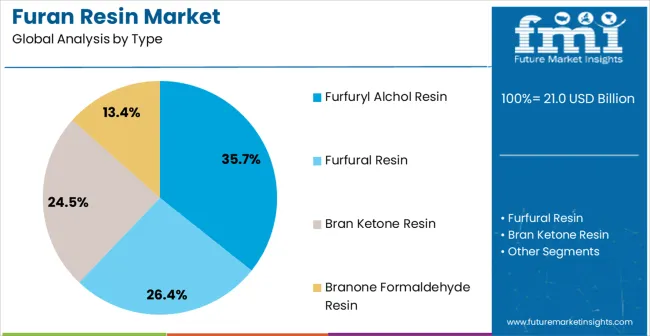
The furfuryl alcohol resin segment is projected to hold 35.7% of the Furan Resin market revenue share in 2025, positioning it as the leading type. This dominance is primarily attributed to its widespread utilization in foundry binders, where strong bonding properties and resistance to high temperatures are critical. Furfuryl alcohol resin offers superior mechanical strength, durability, and environmental performance compared to traditional binders, making it a preferred material in metal casting processes.
In addition, it plays an essential role in the production of adhesives, sealants, and coatings, where its chemical resistance and sustainability benefits align with evolving industrial requirements. Its bio-based origin, derived from renewable feedstock, adds to its appeal as industries shift toward eco-friendly materials. The growing demand for sustainable resins across automotive, construction, and industrial applications is further reinforcing adoption.
Enhanced processing technologies and scalable manufacturing are also contributing to cost efficiency and accessibility As industries continue to prioritize sustainable, high-performance alternatives, the furfuryl alcohol resin type is expected to maintain its leadership and drive significant growth within the Furan Resin market.
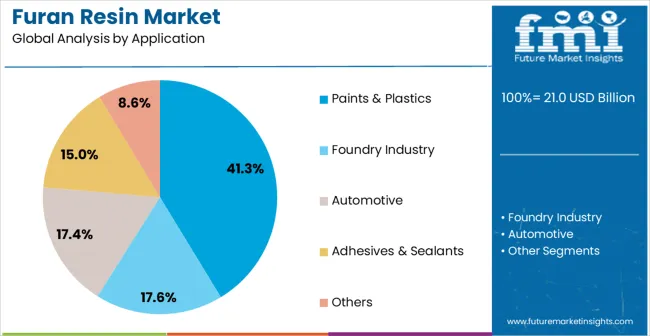
The paints and plastics application segment is anticipated to account for 41.3% of the Furan Resin market revenue share in 2025, making it the largest application area. Growth in this segment is being driven by the resin’s excellent adhesion properties, solvent resistance, and long-lasting performance, which are essential in protective coatings and advanced plastic formulations. Furan resins are increasingly used in high-performance paints to enhance durability, corrosion resistance, and weatherability, particularly in industrial and infrastructure projects where material longevity is critical.
In the plastics sector, they are valued for improving thermal stability and mechanical strength while contributing to sustainability objectives through their bio-based origins. The ability of furan resins to replace petroleum-derived alternatives in paints and plastics is adding momentum to adoption, especially as industries focus on reducing environmental footprints.
Growing investments in construction, automotive, and packaging are further strengthening demand, as these sectors require cost-effective and durable material solutions With regulatory support for eco-friendly products and strong performance advantages, the paints and plastics application segment is set to remain the primary growth driver in the Furan Resin market.
Furan resins are categoried under heterocyclic organic compounds having one oxygen atom and four carbon atoms connected to each other in an aromatic ring-shaped structure. Furan resins are generally soluble in commercially available organic solvents, such as ether, acetone and alcohols.
They are generally colourless, flammable and volatile in nature with a boiling point equivalent to room temperature. These resins harden when heated. The hardening process can be accelerated if heating is done in the presence of an acid catalyst. Furan resins are characterized by high resistance to alkali, acids, chemicals and heat.
Moreover, these furan resins impart exceptional mechanical strength to the end product. Commercially, there are four types of furan resins available in the market, namely furfuryl alcohol resin, furfural resin, bran ketone resin and branone formaldehyde resin. Raw material for furan resins namely furfuryl alcohol, is processed from corn cobs, sugarcane bagasse, oats, and wheat bran among others.
Furfuryl alcohol finds application in aerospace industry as a hypergolic fuel, which shows a characteristic of rapid ignition in the presence of fuming nitric acid. It also finds application as a raw material in the synthesis of specialty chemicals that find adoption in different applications.
Furan resins find adoption on a large scale in applications, such as the foundry industry, synthesis of adhesives and sealants, formulation of plastics and the automotive industry, to name a few. Furan resins are also used as raw materials in the synthesis of polymer mortars and polymer concretes, which exhibit a high level of mechanical strength and increased corrosion resistance.
This concrete is further used in the construction of chemical plants and in chemical equipment as a refractory lining. Furthermore, furan resins are also used as binders in the manufacturing of glass plastics with exceptional hardness.
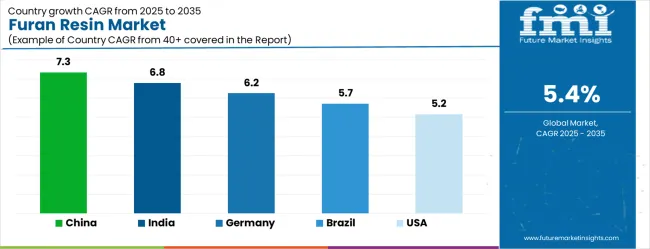
| Country | CAGR |
|---|---|
| China | 7.3% |
| India | 6.8% |
| Germany | 6.2% |
| Brazil | 5.7% |
| USA | 5.2% |
| UK | 4.6% |
| Japan | 4.1% |
The Furan Resin Market is expected to register a CAGR of 5.4% during the forecast period, exhibiting varied country level momentum. China leads with the highest CAGR of 7.3%, followed by India at 6.8%. Developed markets such as Germany, France, and the UK continue to expand steadily, while the USA is likely to grow at consistent rates. Japan posts the lowest CAGR at 4.1%, yet still underscores a broadly positive trajectory for the global Furan Resin Market. In 2024, Germany held a dominant revenue in the Western Europe market and is expected to grow with a CAGR of 6.2%. The USA Furan Resin Market is estimated to be valued at USD 7.9 billion in 2025 and is anticipated to reach a valuation of USD 7.9 billion by 2035. Sales are projected to rise at a CAGR of 0.0% over the forecast period between 2025 and 2035. While Japan and South Korea markets are estimated to be valued at USD 969.3 million and USD 563.3 million respectively in 2025.
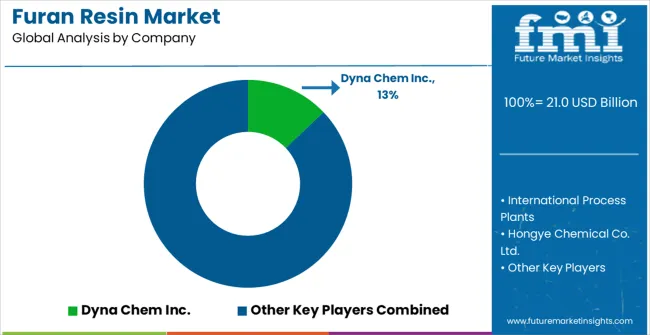
| Item | Value |
|---|---|
| Quantitative Units | USD 21.0 Billion |
| Type | Furfuryl Alchol Resin, Furfural Resin, Bran Ketone Resin, and Branone Formaldehyde Resin |
| Application | Paints & Plastics, Foundry Industry, Automotive, Adhesives & Sealants, and Others |
| Regions Covered | North America, Europe, Asia-Pacific, Latin America, Middle East & Africa |
| Country Covered | United States, Canada, Germany, France, United Kingdom, China, Japan, India, Brazil, South Africa |
| Key Companies Profiled | Dyna Chem Inc., International Process Plants, Hongye Chemical Co. Ltd., Novasynorganics, The Chemical Company, Supply Company, Sweet Lake Chemical Ltd., Nova Molecular Technologies, Ideal Chemical, NeuChem Inc., Penn A Kem LLC, and Shenzhen Shu Hang Industrial Development Co. Ltd |
The global furan resin market is estimated to be valued at USD 21.0 billion in 2025.
The market size for the furan resin market is projected to reach USD 35.6 billion by 2035.
The furan resin market is expected to grow at a 5.4% CAGR between 2025 and 2035.
The key product types in furan resin market are furfuryl alchol resin, furfural resin, bran ketone resin and branone formaldehyde resin.
In terms of application, paints & plastics segment to command 41.3% share in the furan resin market in 2025.






Our Research Products

The "Full Research Suite" delivers actionable market intel, deep dives on markets or technologies, so clients act faster, cut risk, and unlock growth.

The Leaderboard benchmarks and ranks top vendors, classifying them as Established Leaders, Leading Challengers, or Disruptors & Challengers.

Locates where complements amplify value and substitutes erode it, forecasting net impact by horizon

We deliver granular, decision-grade intel: market sizing, 5-year forecasts, pricing, adoption, usage, revenue, and operational KPIs—plus competitor tracking, regulation, and value chains—across 60 countries broadly.

Spot the shifts before they hit your P&L. We track inflection points, adoption curves, pricing moves, and ecosystem plays to show where demand is heading, why it is changing, and what to do next across high-growth markets and disruptive tech

Real-time reads of user behavior. We track shifting priorities, perceptions of today’s and next-gen services, and provider experience, then pace how fast tech moves from trial to adoption, blending buyer, consumer, and channel inputs with social signals (#WhySwitch, #UX).

Partner with our analyst team to build a custom report designed around your business priorities. From analysing market trends to assessing competitors or crafting bespoke datasets, we tailor insights to your needs.
Supplier Intelligence
Discovery & Profiling
Capacity & Footprint
Performance & Risk
Compliance & Governance
Commercial Readiness
Who Supplies Whom
Scorecards & Shortlists
Playbooks & Docs
Category Intelligence
Definition & Scope
Demand & Use Cases
Cost Drivers
Market Structure
Supply Chain Map
Trade & Policy
Operating Norms
Deliverables
Buyer Intelligence
Account Basics
Spend & Scope
Procurement Model
Vendor Requirements
Terms & Policies
Entry Strategy
Pain Points & Triggers
Outputs
Pricing Analysis
Benchmarks
Trends
Should-Cost
Indexation
Landed Cost
Commercial Terms
Deliverables
Brand Analysis
Positioning & Value Prop
Share & Presence
Customer Evidence
Go-to-Market
Digital & Reputation
Compliance & Trust
KPIs & Gaps
Outputs
Full Research Suite comprises of:
Market outlook & trends analysis
Interviews & case studies
Strategic recommendations
Vendor profiles & capabilities analysis
5-year forecasts
8 regions and 60+ country-level data splits
Market segment data splits
12 months of continuous data updates
DELIVERED AS:
PDF EXCEL ONLINE
Resin Silencer Market Size and Share Forecast Outlook 2025 to 2035
Resin Capsule Market Forecast and Outlook 2025 to 2035
Resin Cement for Luting Market Size and Share Forecast Outlook 2025 to 2035
Furandicarboxylic Acid Market Size and Share Forecast Outlook 2025 to 2035
Furan Based Polymer Market Size and Share Forecast Outlook 2025 to 2035
Resin Pigments Market Size and Share Forecast Outlook 2025 to 2035
PE Resins Market Size and Share Forecast Outlook 2025 to 2035
Ink Resin Market Size and Share Forecast Outlook 2025 to 2035
Cast Resin Transformer Market Size and Share Forecast Outlook 2025 to 2035
Agar Resin Market
Epoxy Resin Industry Analysis in Asia Pacific Size and Share Forecast Outlook 2025 to 2035
Amino Resin Market Growth - Trends & Forecast 2025 to 2035
Epoxy Resin Market Growth – Trends & Forecast 2024-2034
Cobalt Resinate Market Size and Share Forecast Outlook 2025 to 2035
Compact Resin Type Silencer Market Size and Share Forecast Outlook 2025 to 2035
Acrylic Resin Market Size and Share Forecast Outlook 2025 to 2035
Barrier Resins Market Size and Share Forecast Outlook 2025 to 2035
Coating Resins Market Size and Share Forecast Outlook 2025 to 2035
2-Methylfuran Market Size and Share Forecast Outlook 2025 to 2035
Plastic Resins Market Size, Share & Forecast 2025 to 2035

Thank you!
You will receive an email from our Business Development Manager. Please be sure to check your SPAM/JUNK folder too.
Chat With
MaRIA